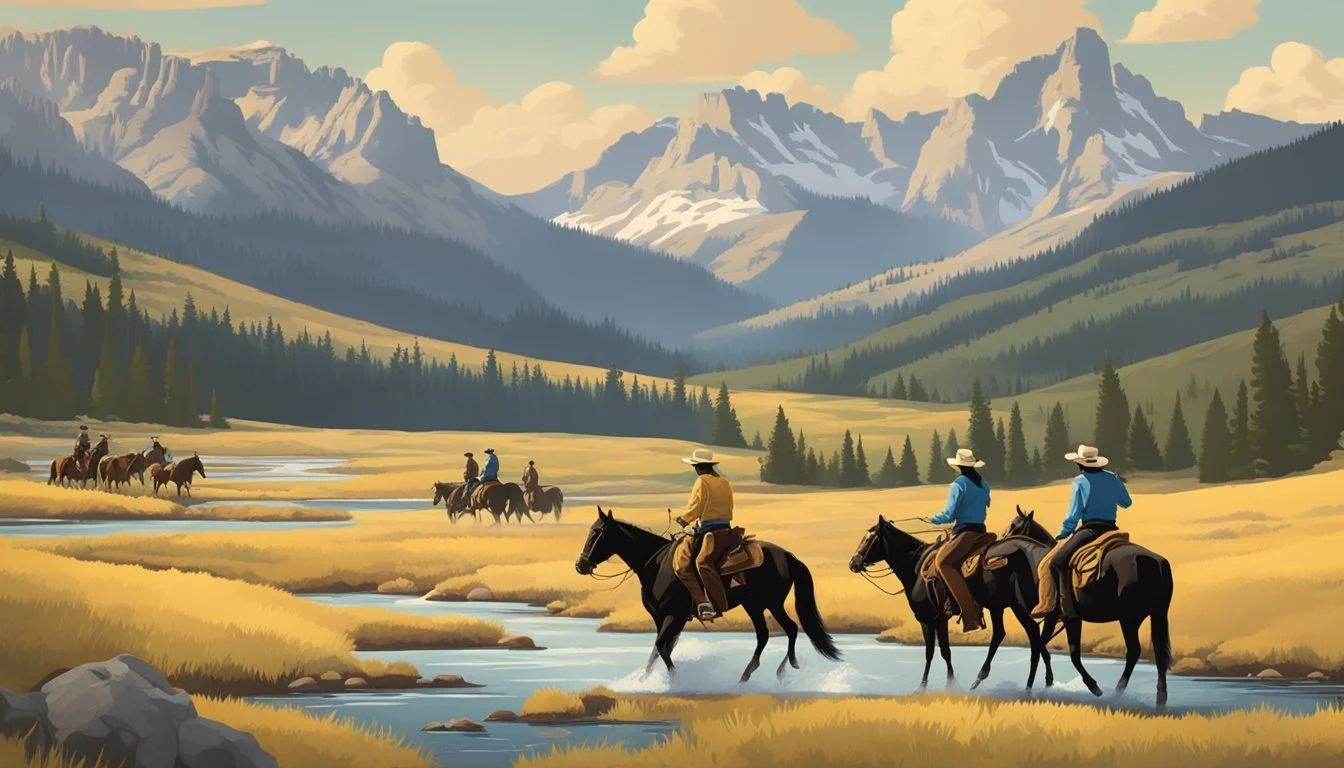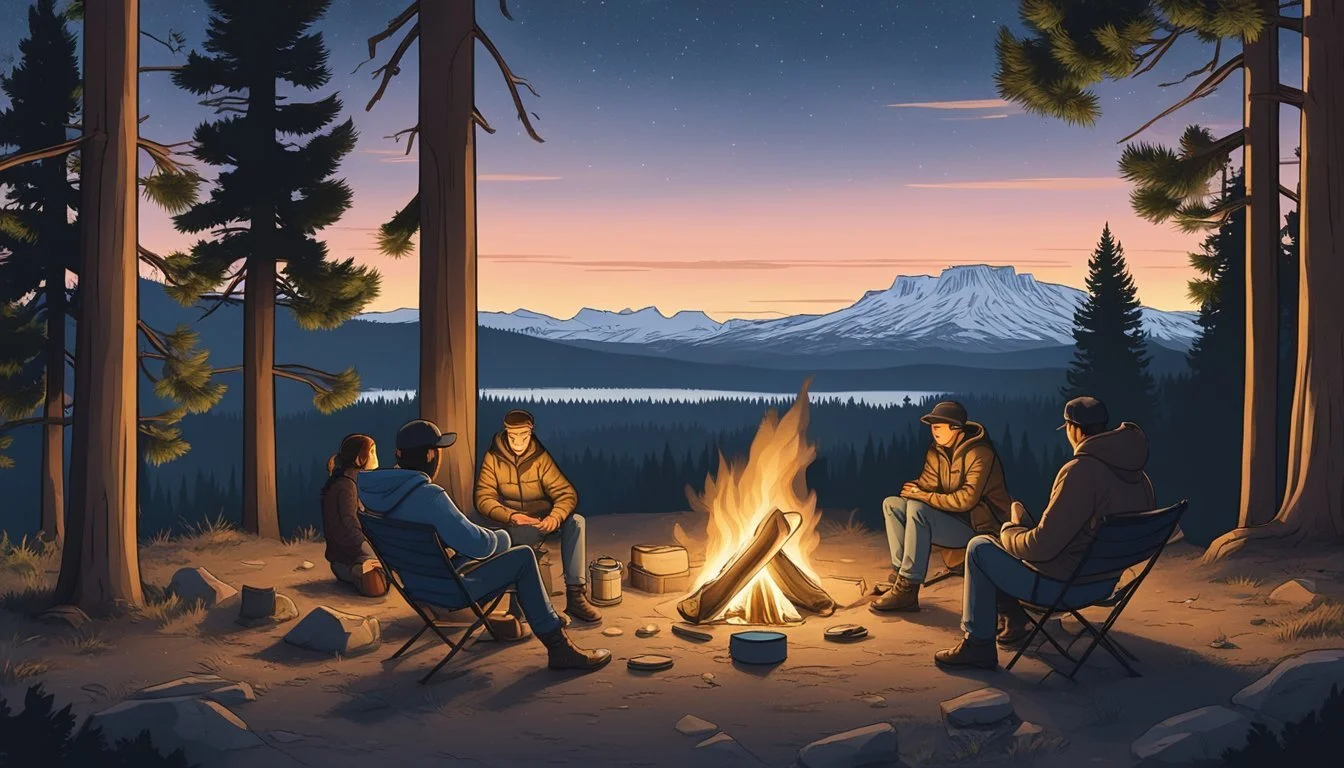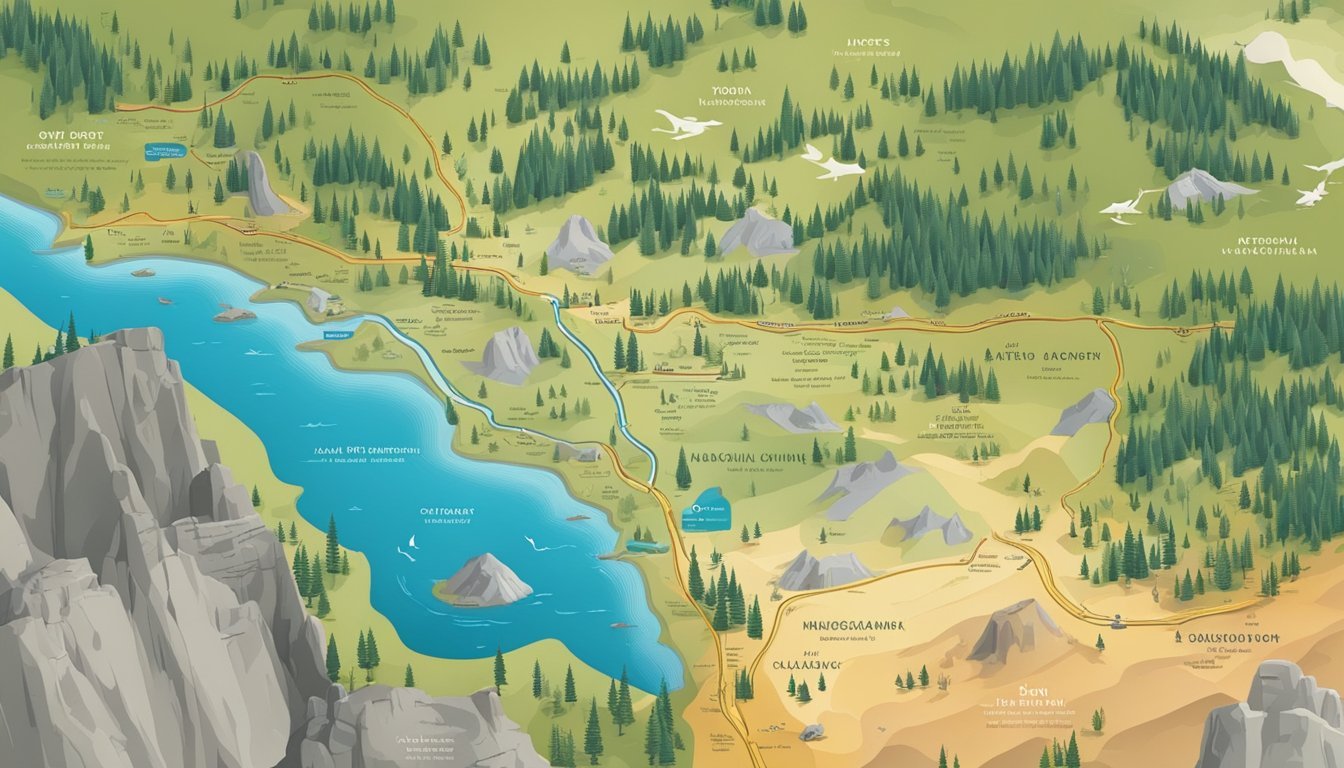Experience the Thrill of a Lifetime with Your Ultimate Trip Yellowstone Adventure
The hit TV series Yellowstone has captivated audiences with its gripping portrayal of the Dutton family's struggles to maintain their vast ranch bordering Yellowstone National Park. For fans eager to immerse themselves in the show's world, a trip to the filming locations offers a unique opportunity to experience the breathtaking landscapes and Western atmosphere firsthand.
Visitors can explore several key Yellowstone filming sites, including the real Dutton Ranch located in Darby, Montana. While the property is a working ranch, it allows fans to take photos at the entrance gate when filming is not in progress. Some lucky guests can even stay overnight in cabins featured on the show, such as Lee Dutton's and Rip's accommodations.
Beyond the ranch, a Yellowstone-inspired trip can include visits to Yellowstone National Park itself, where iconic features like Old Faithful and the Midway Geyser Basin showcase the region's natural wonders. Other filming locations span Utah, Montana, and Texas, offering fans a chance to piece together their own Yellowstone adventure across the American West.
Overview of Yellowstone National Park
Yellowstone National Park, established in 1872, is America's first national park. Located primarily in Wyoming, it spans over 2.2 million acres of diverse landscapes.
The park is renowned for its geothermal features, including geyser basins, hot springs, and mud pots. Old Faithful, its most famous geyser, erupts with impressive regularity.
Yellowstone's ecosystem supports diverse wildlife, including bison, elk, wolves, and grizzly bears. The park's landscapes range from forests and grasslands to canyons and alpine areas.
Geologically significant, Yellowstone sits atop a supervolcano. This geological hotspot fuels the park's unique thermal features and shapes its dramatic terrain.
Visitors can explore over 900 miles of hiking trails, observe wildlife, and witness geothermal wonders. The park offers camping, fishing, and educational programs throughout the year.
Yellowstone's preservation efforts balance conservation with public access. Park rangers and scientists work to protect its natural resources and study its unique ecosystems.
The park faces challenges such as climate change, invasive species, and balancing tourism with conservation. Despite these issues, Yellowstone remains a symbol of America's natural heritage.
Planning Your Trip
Careful preparation is key to a successful Yellowstone adventure. Consider factors like seasonal conditions, accommodation options, and transportation logistics to make the most of your visit.
Determining the Best Time to Visit
Summer offers the best weather and full access to park facilities, but crowds peak from June to August. Spring and fall provide milder temperatures and fewer visitors. May and September are ideal for wildlife viewing and scenic drives.
Winter transforms Yellowstone into a snowy wonderland. Limited road access means fewer crowds, but many services are closed. Guided snowmobile or snowcoach tours offer unique experiences.
Consider your priorities when choosing dates. Wildlife enthusiasts may prefer shoulder seasons. Hikers and campers should aim for summer. Photography buffs can capture stunning landscapes year-round.
Accommodations and Lodging Options
Yellowstone offers diverse lodging choices. Book well in advance, especially for peak season stays.
In-park options include:
Historic lodges like Old Faithful Inn
Rustic cabins
Campgrounds (both reservable and first-come, first-served)
Gateway towns provide additional choices:
West Yellowstone: Hotels, motels, vacation rentals
Gardiner: Budget-friendly options, bed and breakfasts
Cody: Ranch stays, historic hotels
For a unique experience, consider:
Glamping sites near park entrances
RV rentals for a road trip adventure
Travel and Transportation
Flying to Yellowstone? The closest airports are:
Bozeman Yellowstone International (BZN)
Jackson Hole Airport (JAC)
West Yellowstone Airport (WYS) - seasonal service
Renting a car is highly recommended for exploring the park. The Grand Loop Road connects major attractions, but expect slow traffic during peak times.
Consider entering through the scenic Beartooth Highway for breathtaking views. This route is typically open from late May to mid-October.
Public transportation options are limited. Some lodges offer shuttle services to nearby attractions.
Essential Tips and Logistics
Purchase an America the Beautiful pass for multiple park visits. It covers entrance fees for a full year.
Pack layers for unpredictable weather. Bring bear spray for hiking trails.
Download offline maps and the official Yellowstone app for navigation. Cell service is limited within the park.
Plan your itinerary around geyser eruption times. Old Faithful's schedule is posted at visitor centers.
Make dining reservations in advance for popular in-park restaurants. Pack picnic supplies for scenic lunch stops.
Stay informed about wildlife safety and park regulations. Always maintain a safe distance from animals.
Famous Attractions in Yellowstone
Yellowstone National Park boasts numerous iconic attractions that draw millions of visitors each year. These natural wonders showcase the park's unique geothermal features, diverse wildlife, and stunning landscapes.
Old Faithful and Upper Geyser Basin
Old Faithful is Yellowstone's most famous geyser, erupting approximately every 90 minutes. The Upper Geyser Basin surrounding it contains the highest concentration of geysers in the world. Visitors can witness spectacular eruptions from various viewing points.
The basin is home to other notable geysers like Castle, Grand, and Beehive. Boardwalks provide safe access to these features, allowing close-up views of colorful hot springs and steaming fumaroles.
The visitor center offers eruption predictions and educational exhibits about the park's hydrothermal features. Rangers conduct guided walks and talks throughout the day, providing insights into the area's geology and ecology.
Grand Canyon of the Yellowstone
The Grand Canyon of the Yellowstone stretches for 20 miles, with depths up to 1,200 feet. Its colorful rock walls and thundering waterfalls create a breathtaking landscape.
The Lower Falls, dropping 308 feet, is the canyon's most photographed feature. Artist Point and Inspiration Point offer stunning vistas of the falls and canyon. Visitors can hike various trails along the rim for different perspectives.
The North Rim Drive and South Rim Drive provide easy access to multiple viewpoints. Uncle Tom's Trail, a steep staircase, descends partway into the canyon for a closer view of the Lower Falls.
Mammoth Hot Springs
Mammoth Hot Springs features a series of terraced, limestone formations created by mineral-rich hot water. The area's constantly changing landscape includes vibrant colors and unique shapes.
Visitors can explore the Upper and Lower Terraces via boardwalks and short trails. Notable features include Minerva Terrace, Palette Spring, and Liberty Cap. The nearby historic Fort Yellowstone offers insights into the park's early days.
Wildlife sightings are common in this area, with elk often grazing on the lawns. The Mammoth Hot Springs Hotel and surrounding buildings form one of the park's main developed areas.
Lamar and Hayden Valleys
Lamar and Hayden Valleys are prime wildlife viewing areas in Yellowstone. Lamar Valley, known as America's Serengeti, is home to herds of bison, elk, and pronghorn. Wolves and grizzly bears are also frequently spotted here.
Hayden Valley, located along the Yellowstone River, offers similar wildlife viewing opportunities. Both valleys feature expansive grasslands and meandering rivers, creating ideal habitats for diverse species.
Early morning and late evening are the best times for wildlife observation. Pullouts along the roads allow visitors to safely park and use binoculars or spotting scopes. Rangers often set up scopes at popular viewing areas to help visitors spot animals.
Norris Geyser Basin
Norris Geyser Basin is the hottest and most changeable thermal area in Yellowstone. It consists of two main areas: Porcelain Basin and Back Basin. Steamboat Geyser, the world's tallest active geyser, is located here.
Porcelain Basin features a stark landscape with milky blue pools and steaming vents. Back Basin offers a more forested setting with numerous geysers and hot springs. Boardwalks provide safe access to both areas.
The Norris Geyser Basin Museum offers exhibits on the area's unique geology. Rangers lead guided walks to explain the basin's features and ever-changing nature.
Yellowstone Lake
Yellowstone Lake is the largest high-elevation lake in North America. Its vast expanse of clear, cold water is surrounded by pristine forests and thermal features. The lake offers opportunities for fishing, boating, and scenic drives.
West Thumb Geyser Basin, located on the lake's shore, presents a unique combination of lakeside hot springs and geysers. The historic Lake Hotel provides lodging with panoramic views of the lake and surrounding mountains.
Visitors can take boat tours or rent kayaks to explore the lake's 110 miles of shoreline. The area is also known for its abundance of wildlife, including bison, elk, and waterfowl.
Wildlife Viewing and Outdoor Activities
Yellowstone National Park offers unparalleled opportunities to observe diverse wildlife and engage in outdoor adventures. Visitors can witness iconic animals in their natural habitats, explore scenic hiking trails, and take in breathtaking views on park tours.
Experiencing Yellowstone's Wildlife
Yellowstone's northern range and Lamar Valley are prime locations for wildlife viewing. Visitors can spot elk, bison, bears, and wolves roaming freely. Early morning and late afternoon are ideal times for animal sightings.
Winter provides a unique perspective, with fewer crowds and snow-covered landscapes enhancing the experience. Guided wildlife tours led by knowledgeable naturalists offer insights into animal behaviors and habitats.
Responsible wildlife viewing is crucial. Maintain a safe distance from animals and use binoculars or telephoto lenses for close-up views.
Hiking Trails and Nature Walks
Yellowstone boasts diverse hiking options for all skill levels. Popular trails include:
Old Faithful Geyser Loop (easy)
Grand Canyon of Yellowstone (moderate)
Mount Washburn (challenging)
These trails showcase the park's geothermal features, canyons, and alpine meadows. Always carry bear spray and hike in groups for safety.
Nature walks provide opportunities to observe smaller wildlife and learn about Yellowstone's unique ecosystems. Rangers often lead educational programs on flora and fauna.
Scenic Drives and Park Tours
Scenic drives offer a comfortable way to explore Yellowstone's vast landscapes. The Grand Loop Road covers major park attractions, including:
Mammoth Hot Springs
Norris Geyser Basin
Yellowstone Lake
Custom park tours allow visitors to maximize their time and learn from experienced guides. These tours often combine wildlife viewing with visits to key geological features.
For a one-day Yellowstone itinerary, focus on the Upper Geyser Basin and Grand Canyon areas. This route provides a mix of wildlife sightings and iconic park landmarks.
Beyond Yellowstone: Grand Teton National Park
Grand Teton National Park offers stunning mountain vistas and diverse wildlife. This rugged landscape features pristine lakes, winding rivers, and abundant hiking trails.
Exploring Grand Teton
The Teton Range dominates the park's skyline with its jagged peaks. Visitors can drive the 42-mile Scenic Loop Drive for panoramic views. Wildlife sightings are common, including elk, moose, and bison.
The Craig Thomas Discovery and Visitor Center provides orientation and exhibits. Colter Bay Village offers lodging, dining, and water activities on Jackson Lake. For a spiritual experience, the rustic Chapel of the Transfiguration frames a perfect view of the mountains through its altar window.
Photographers flock to Snake River Overlook, made famous by Ansel Adams. The winding Snake River provides opportunities for fishing and rafting adventures.
Jenny Lake and Surrounding Trails
Jenny Lake is a focal point for outdoor activities. A scenic boat shuttle crosses the lake, providing access to Hidden Falls and Inspiration Point trails.
The Hidden Falls trail is a moderate 1.3-mile round trip hike to a 100-foot cascading waterfall. Continuing upward, Inspiration Point offers sweeping views of Jenny Lake and the valley below.
For a challenging day hike, the 7.5-mile Cascade Canyon Trail begins near Jenny Lake. It winds through forests and meadows with stunning mountain views. Lucky hikers may spot black bears or moose along the way.
Practical Information
Yellowstone National Park offers unique challenges and opportunities for visitors. Being prepared with key information will enhance your experience and ensure a safe, enjoyable trip.
Staying Connected at Yellowstone
Cell service in Yellowstone is limited. Coverage is available near major developed areas like Mammoth Hot Springs, Old Faithful, and Canyon Village. Most remote areas have no service.
Wi-Fi is offered at select locations, including some visitor centers and lodges. Signal strength can be weak due to high demand.
Consider downloading offline maps and guides before your trip. Inform family and friends of your itinerary, as communication may be sporadic.
Safety and Wildlife Guidelines
Yellowstone's wildlife and geothermal features require caution. Stay on designated boardwalks and trails. Maintain a distance of at least 100 yards from bears and wolves, and 25 yards from other animals.
Never feed wildlife. Store food properly to avoid attracting animals to campsites.
Be aware of rapidly changing weather conditions. Pack layers and rain gear, even in summer.
Drink plenty of water to avoid altitude sickness. The park's average elevation is 8,000 feet.
Visitor Centers and Amenities
Yellowstone has nine visitor centers spread throughout the park. These offer exhibits, ranger programs, and information services.
Key visitor centers include:
Old Faithful Visitor Education Center
Canyon Visitor Education Center
Albright Visitor Center at Mammoth Hot Springs
Most centers are open daily in peak season (May-September). Hours vary in shoulder and winter seasons.
Amenities like gas stations, general stores, and dining options are available in major developed areas. Stock up on supplies before entering remote parts of the park.




